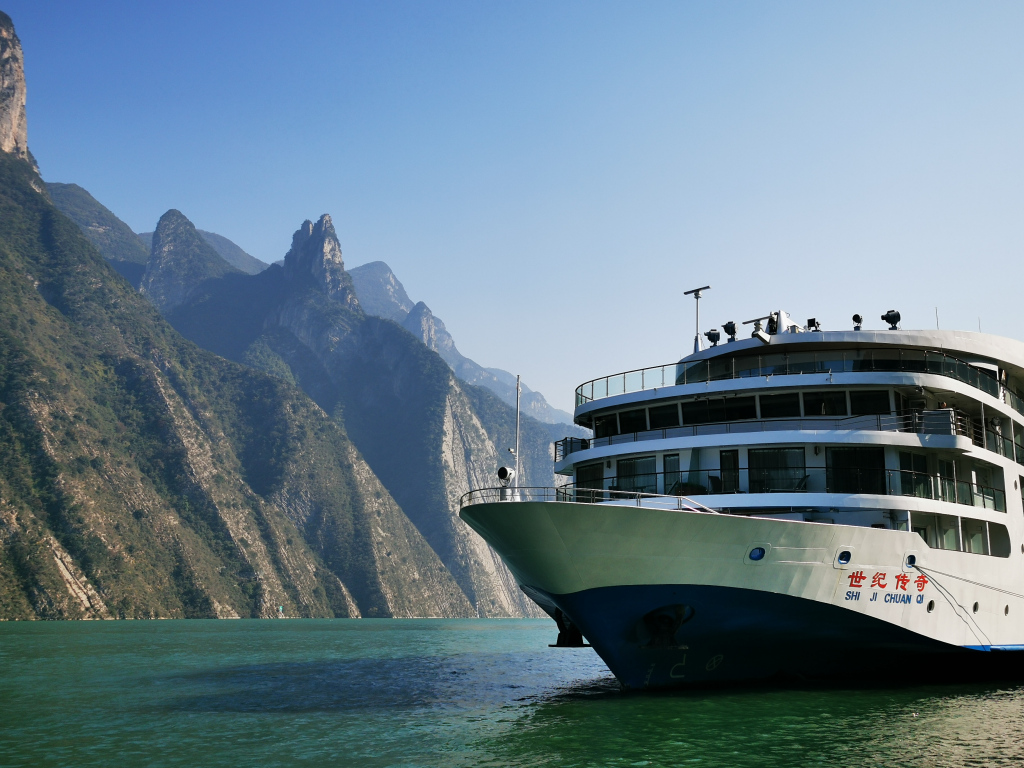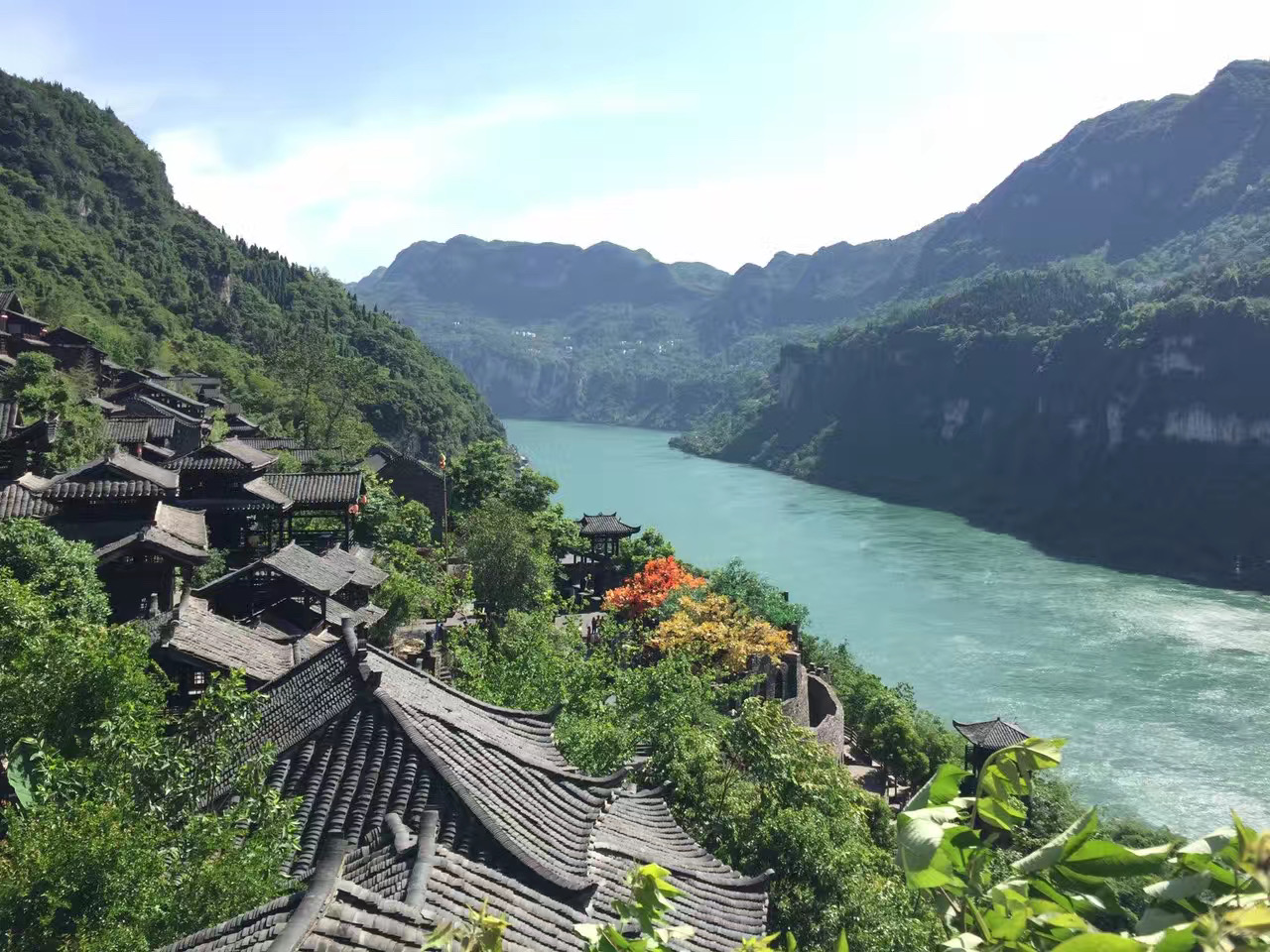The Three Gorges
2023-07-04 17:40

Qutang Gorge extends eastward from White Emperor Town to Daxi Town. Since the gorge is no more than eight kilometers long a downstream voyage is a short trip away. It has the capability of controlling the waters from Sichuan in the east and dominating the mountains of Hubei in the west. The river is flanked with steep cliffs and towering peaks. Mt. ChiJia in the north and Mt. Baiyan in the south penetrate into the sky facing each other closely with the bluffs almost touching in mid-air teetering dangerously. Looking from a distance on a fine day, one sees the former resembling a huge pink peach and the latter a huge heap of white salt constantly glittering. The two mountains disappear into the mist and clouds every now and then, creating one of the most spectacular scenes of the Yangtze gorges. The widest spot of the river is about two hundred meters and the narrowest spot is only ten meters.

At Kuimen, the steep cliffs on either side look like two gigantic doors closing in on the roaring river and holding the strategic pass between Sichuan and Hubei perilously. Kuimen has been marveled as the most dangerous pass in the world. Darkening the daylight with only a narrow opening and the thundering river rolling by vigorously, it sounds like thousands of horses galloping ahead. You can’t help but marvel at the scene and wonder whether you are sailing.
WU GORGE:

The Wu Gorge is named after Wushan Mountain . The beautiful gorge runs 45 kilometers from the mouth of the Daning River in Wushan County , Chongqing , to Guandukou in Badong County . Huibei province, with the Bianchengxi serving as the dividing line between Chongqing and Hubei .
Along the Wu Gorges, twelve peaks are the best attractions to tourists. On the northern bank of this part of the Yangtze from west to east stand six peaks: Denglong, Shengquan, Chaoyun, Shennu, Songluan, and Jixian; on the southern bank only three peaks are visible to the passenger on a ship; Feifeng, Cuiping and Juhe, while the three other peaks, Jiangtan, Qiyun and Shangsheng are hidden behind the mountains as they stand a little way off from the Yangtze, Denglong, 1,210 meters above sea level is the highest peak among them, while the 940-meters Qiyun is the lowest. The 940 meters Shennv or the Goddess Peak is also known as Greeting the Rosy Clouds Peak, because its column like top seems always to be greeting the rosy clouds both at sunrise and at sunset. It is named the Goddess had fallen in love with King Xiang of the state Chu, and they enjoyed their meeting in Wushan Mountain, and in his dream the king was told by the goddess that she would appear as the cloud at dawn and as rain at sunset. As the Wu Gorge is long and valley deep, and the area is crowded with piles and piles of mountains and peaks, and so the area is very often shrouded in mist or a curtain of rain. Therefore, the clouds and rain of Wushan became the theme of many poems and paintings in Chinese history.
“The Wu Gorges is layers upon layers of mountains and peaks, which are famous for their magnificent scenery, the twelve peaks of Wushan Mountains .” The fifteen large Chinese characters, said to be written by Zhuge Liang (Kongming), prime minister of the State of Shu (221-265), are inscribed on a rock cliff of the Jixian Peak over the river, and therefore is known as “the Kongming Tablet”. But in fact the first six characters were carved during the reign of Emperor Jiajing (1522-1567) of the Ming Dynasty, and the last nine characters have almost been worn away which makes studies almost impossible.
XILING GORGE:

The Xiling Gorge in Hubei province, the last of the Three Gorges on the Yangtze, is 75 kilometers long from the mouth of the Xiang Stream to Nanjing Pass. In the gorges there is a break of 35 kilometers of open valley, so the gorge is actually 40 kilometers long. Therefore, ancient people were justified in believing the Wu Gorge to be the longest. As the poem says, “Among the Three Gorges to the east of Ba, the longest is the Wu Gorge”. In the past, the Xiling Gorge used to be a dangerous part of the Yangtze for boats because of its numerous dangerous shoals, reefs and whirlpools in the river. But thanks to efforts made in dredging the waterway after liberation in 1949, specifically since the completion of the Gezhouba Dam Project, this part of the Yangtze has become a safe and beautiful waterway.
In the Xiling Gorge, west of the open valley stands the Bingshu Baijian Gorge (the Gorge of Military Books and Swords) and the Niugan Mafei Gorge (the Gorge of Ox Livers and Horse Lungs), and east of the open valley are the Huangniu Gorge (the Yellow Ox Gorge) and the Dengying Gorge (the Lamp Shadow Gorge). All these names suggest their appearances. The most famous historical sites, cultural relics, and natural scenery in this area are the Huangling Temple and the Sanyou Cave.
The Huangling Temple is located on the southern bank of the Yangtze, 620 kilometers from the central part of Chongqing. The temple is the largest ancient building in the Xiling Gorges area, first built during the Spring and Autumn period (770-476 B.C), then rebuilt in the Tang Dynasty and repaired in 1618 during the Ming Dynasty. Inside the gate there is an opera building housing a stage, King Yu’s Palace, and a Memorial Temple of Zhuge Liang.
Inside the memorial temple was a stone tablet of the temple, but unfortunately the tablet is no longer there. There stands a three-meter tablet on the west side of King Yu’s Palace; on the tablet is inscribed “Note on Dredging the River” carved in 1773. After recent repairs, the temple now looks magnificent.

The Sanyou Cave is located on the northern bank of the Yangtze ten kilometers from the urban area of Yichang. The cave was the place where Bai Juyi and two other famous poets of the Tang Dynasty gathered and later they wrote poems about their visit to the cave. Therefore, the cave was named Sanyou cave, meaning, “cave visited by three”. Later three scholars of the Song Dynasty, Su Xun and his sons Su Shi and Su Zhe, also visited the cave, and their visit was known as the “later visit by three”.









